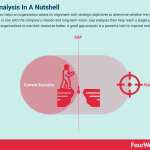Gap Analysis In A Nutshell

A gap analysis helps an organization assess its alignment with strategic objectives to determine whether the current execution is in line with the company’s mission and long-term vision. Gap analyses then help reach a target performance by assisting organizations to use their resources better. A good gap analysis is a powerful tool to improve execution.
Gap analysis to structure an effective action plan
Gap analyses also help to assess how in line is the company’s organization vs. the action plan defined in the stage of planning. Thus, helping reach target goals given the current state. The gap between the target objectives and the current state needs to be broken down in steps, small enough to be executable and measurable.
Gap analysis to identify focus areas
Gap analyses also help to identify focus areas and simplify the execution strategy. Indeed, while business planning tends to complicate things, a gap analysis is useful to identify a few key areas of interest for the upcoming strategy initiatives.
Gap analysis and process improvement
Gap analyses also help with improvement in business processes. Indeed, gap analyses can help identify organizational inefficiencies thus identify quality management processes such as Lean, Scrum, Kaizen, or Six Sigma.
Gap analysis and KPIs
The gap analysis starts also by determining a future state the company is envisioning, which can follow several principles, and in general, that needs to be ambitious yet reachable, measurable, and breakable.
Gap Analysis Frameworks & Tools
[image error]Porter’s Five Forces is a model that helps organizations to gain a better understanding of their industries and competition. Published for the first time by Professor Michael Porter in his book “Competitive Strategy” in the 1980s. The model breaks down industries and markets by analyzing them through five forces
Read: Porter’s Five Forces Framework
[image error]A SWOT Analysis is a framework used for evaluating the business’s Strengths, Weaknesses, Opportunities, and Threats. It can aid in identifying the problematic areas of your business so that you can maximize your opportunities. It will also alert you to the challenges your organization might face in the future.
Read: SWOT Analysis
[image error]The PESTEL analysis is a framework that can help marketers assess whether macro-economic factors are affecting an organization. This is a critical step that helps organizations identify potential threats and weaknesses that can be used in other frameworks such as SWOT or to gain a broader and better understanding of the overall marketing environment.
Read: PESTEL Analysis
[image error]You can use the Ansoff Matrix as a strategic framework to understand what growth strategy is more suited based on the market context. Developed by mathematician and business manager Igor Ansoff, it assumes a growth strategy can be derived by whether the market is new or existing, and the product is new or existing.
Read: Ansoff Matrix
[image error]In the FourWeekMBA growth matrix, you can apply growth for existing customers by tackling the same problems (gain mode). Or by tackling existing problems, for new customers (expand mode). Or by tackling new problems for existing customers (extend mode). Or perhaps by tackling whole new problems for new customers (reinvent mode).
Read: Growth Matrix
The post Gap Analysis In A Nutshell appeared first on FourWeekMBA.



